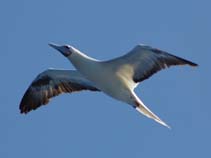Sula sula (Linnaeus, 1766)
Red-footed booby| Native range | All suitable habitat | Point map | Year 2050 |

|
| This map was computer-generated and has not yet been reviewed. |
| Sula sula AquaMaps Data sources: GBIF OBIS |
Classification / Names Common names | Synonyms | CoL | ITIS | WoRMS
Aves | Pelecaniformes | Sulidae
Environment: milieu / climate zone / depth range / distribution range Ecology
Pelagic; depth range 0 - 10 m (Ref. 59262). Subtropical; 22°C - ? (Ref. 84934); 23°N - 24°S, 39°E - 6°W
Distribution Countries | FAO areas | Ecosystems | Occurrences | Introductions
Indo-Pacific, Atlantic Ocean and the Arctic: from Mozambique east to northern Australia and Colombia and Brazil, north to Hawaii and south to Pitcairn Islands.
Length at first maturity / Size / Weight / Age
Maturity: Lm ? range ? - ? cm Max length : 77.0 cm TL male/unsexed; (Ref. 8812); max. published weight: 1.5 kg (Ref. 356)
Short description Morphology
Life cycle and mating behavior Maturity | Reproduction | Spawning | Eggs | Fecundity | Larvae
Main reference
References | Coordinator | Collaborators
Li, X. 1990 Seabirds in China. Bulletin of Biology 4:8-11. (Ref. 78638)
IUCN Red List Status
(Ref. 130435: Version 2025-1)
CITES status (Ref. 108899)
CMS (Ref. 116361)
Threat to humans
Human uses
| FishSource |
Tools
More information
Maturity
Fecundity
Spawning
Eggs
Egg development
Larvae
Internet sources
BHL | BOLD Systems | CISTI | DiscoverLife | FAO(Publication : search) | Fishipedia | GenBank (genome, nucleotide) | GloBI | Gomexsi | Google Books | Google Scholar | Google | PubMed | Tree of Life | Wikipedia (Go, Search) | Zoological Record



